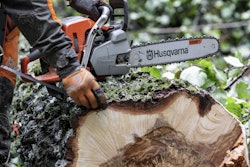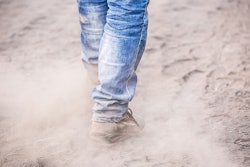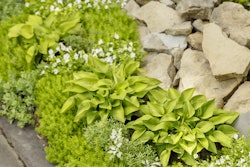 Photo: Neave Group Outdoor Solutions
Photo: Neave Group Outdoor SolutionsIf the thought of March Madness has visions of basketballs and sports courts dancing through your customers’ heads, you can help them create the court of their dreams.
You don’t have to limit yourself to basketball courts, either. There are many sports that customers might want to enjoy in the privacy of their backyard, including tennis, volleyball and golf. If you are wondering if sports court installations might be service worth adding, here’s what you need to know.
Consider your customer base
The first step to deciding if installing sports courts is worth your time is to examine your current customer base and demographics. A court is a luxury item, so if none of your clients can afford this sort of service, there’s no point offering it.
The Neave Group Outdoor Solutions, based in Wappingers Falls, New York, serves a number of high-end clients in areas such as Westchester, so this is why they have the Neave Sports division.
“For landscapers wanting to take it on, we started out doing sports courts because we were already doing landscaping,” says Glen Baisley, marketing director for Neave Group. “We were already doing so many other things outdoors, so it was just an added service as we started getting more people asking for it.”
Other aspects to consider are whether or not there is a demand in your region from homeowners for sports courts and if you have staff that could handle that sort of work. If you don’t feel your crews are qualified to handle the work, you can always consider turning to specialized subcontractors if there are a lot of calls for sports courts in your area that you want to capitalize on.
Baisley says that typically, their clients choose to add sports courts to their space when they are already doing other additions or are renovating the landscape.
“Depending on the size, most of the smaller end of the courts with full landscaping typically start in $40,000 or more range by the time you add lighting and beautiful landscaping,” he says.
Types of courts
The type of customer you’re working with will determine what sport court you end up creating. People with younger children or families are often interested in getting the most out of their courts and tend to want multi-use courts. These can be either half or full-size courts, depending on the space available in the landscape.
For individuals who aren’t certain as to what they’re wanting out of their personal court, ask questions to find out what their true needs are and how often it will realistically be used.
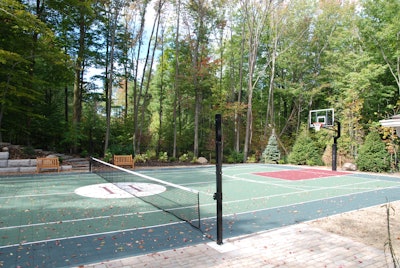 Multi-use courts allow customers to get more bang for their buck.
Multi-use courts allow customers to get more bang for their buck.Photo: T. O’Donnell Landscaping
When the sports courts requests get more specific, Baisley says these individuals tend to be avid players who enjoy the sport and intend to use their court a lot. He says people who request tennis courts tend to be aficionados who know exactly what they want when it comes to their court.
Baisley says customers who request basketball courts tend to want them to be regulation size, but Neave Group always looks at the site before making recommendations.
“We’ll be able to look and see what will best fit in with the aesthetic of the landscape and the size of the landscape,” Baisley says. “Also, we look at the overall picture of what they want to do in the future. You put in a decent sized court and if you have a limited landscape, it will occupy a lot of space if you want to put other things in later on. We’ll look at it and really listen to what they’re looking to do in the future so we can best accommodate their needs.”
As for the playing surface, the Neave Group does either concrete or Flex Court installations. Flex Court is a system of modular tiles that provide a professional finished look and a surface that is easier on the joints.
“If you don’t really have a restricted budget, Flex Court is really the answer because it’s a beautiful looking court that can be custom designed to look in any appearance,” Baisley says. “We’ve had customers do it with their favorite team’s logos. It comes in a variety of colors and you can put it in any custom pattern that you want. It’s a more premium item.”
Baisley says they tend to recommend Flex Court to those who intend to play for longer periods of time. The standard concrete surface is the more cost-effective option for homeowners. Despite Flex Court not being inexpensive, Baisley says it has become more popular lately.
Challenges to expect
Because every landscape is different, there’s no telling what factors might end up being a challenge on each particular job site, but ensuring there is proper grading and drainage are major elements to keep in mind.
“It’s not just the court,” Baisley says. “First off, we have to look at the space. Does the land need to be graded to go in? Is it level? Is it flat? Is there some sort of landscape construction that needs to be done other than just pouring the concrete and putting the tile on it? What’s underneath the soil? Can you dig down? Is there bedrock just under the soil where they want to put it? We have to look at those factors as well.”
Permitting is also important since each town has varying restrictions and legislation, but majority of the time you’ll need to get a permit for installing a sports court.
Features to include
To really make a sports court fit in with the customer’s landscape and be a functional element in the space, it takes more than creating just the court itself.
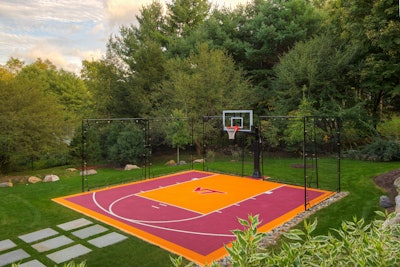 Photo: Neave Group Outdoor Solutions
Photo: Neave Group Outdoor SolutionsOne of the major features to always strive to include is landscape lighting.
“We always make suggestions for lighting,” Baisley says. “Unless they emphatically say they don’t want any lighting and they just want the court, we always put it in the design. We’ll listen to what their usage is, if they only play during the day, or ‘I get home and I like to play in the evening’, it’s going to need lighting. It varies on the clients’ needs. A client will get far more usage out of it with their outdoor space if there’s proper lighting around it, especially in the summer time when you’re more apt to use it for longer stretches of time, you want it properly lit.”
Adding landscaping and seating around the space can also help it blend more with the aesthetic of the property. Observe the area and make suggestions that can improve the usability of the court.
“We’ve been doing it for so many years,” Baisley says. “We have such an expert team in landscape architecture and landscape design/build that we have such a pool of resources behind us that we can look at a property not just from one perspective but a talent pool to give the best recommendation.”
